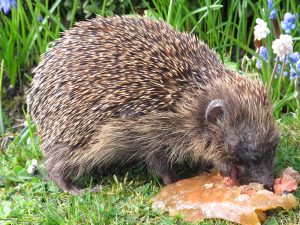
Mention wildlife to most gardeners and they will go gooey eyed over hedgehogs, Jenny wrens and thrushes. However, their survival relies on complex food webs involving creatures that gardeners aren’t quite a keen on! Hedgehogs, for instance, have small mouths and a snout, so their preferred foods during the summer months are beetles, caterpillars and earthworms. They also eat smaller numbers of millipedes, small mammals (dead or alive?), earwigs and cranefly larva. In spring they will take ground-nesting birds’ eggs and they were persecuted by gamekeepers in the distant past. In autumn, they take some slugs, although not in great numbers according to the British Hedgehog Society.
Thrushes rely on large garden snails, especially when they have fledgelings in the nest. They are adept at smashing the shells on hard anvil stones and I leave some small slabs in my borders to help them out. Jenny wrens take small insects and they will enter greenhouses and cold frames in the process. Snails and slugs are part of many a food web and they deserve to be seen as wildlife too. You can’t have one without the other, to parody that famous old song about love and marriage.
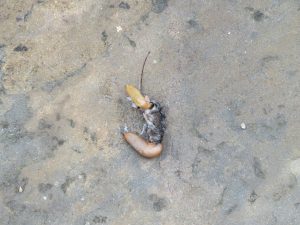
Gardeners do not welcome slugs and snails, so there was outrage when Dr Andrew Salisbury, the Principal Entomologist of the RHS, suggested that they should treat them as garden visitors rather than pests. Petunias and hostas were the main argument. Dare I say it. Our planet IS more important than your hostas and petunias! And our country is suffering, we have to face it. Wildlife is declining so quickly is due to human activity and that includes gardeners eradicating important food sources at the lower end of the spectrum. They’re also turning gardens into sterile environments, neat affairs with no hiding places. I’d put all strimmers into 101, if I could!
Many do not realise that when they use a pesticide, or a so-called green alternative like garlic spray, they zap every soft-bodied creature that comes into contact with the spray, not just their aphids. Ladybird larvae, lacewings, hoverfly larvae and pollinators will all perish. What will the robin or wren do then, poor things? That’s a poem, not a song, by the way!
Your chemical slug bait will find its way into watercourses and drinking water. That’s the very reason blue metaldehyde slug pellets are no longer available. People were drinking unsafe water.
How bad is it? Well, a recent survey by The Natural History Museum produced a list of 240 countries and ranked them according to their natural biodiversity. The UK was placed in 189th position. Gardeners need to change their approach, because our wildlife supports us physically and mentally. We need our pollinators and our detritus eaters in order to survive, because we’re all in it together folks.
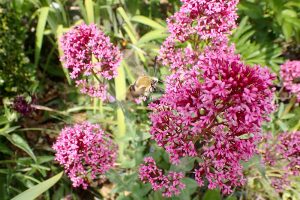
The first step is to give up your chemical jollop, because those chemical substances upset your natural balance, pollute the environment an get into our bodies. I have never used any of these things and my garden’s healthy and full of flower. Embrace the whole spectrum of wildlife in your garden, the little and the large.
The second thing gardeners can do is to create diversity within their own plot. I’ve found that very easy, because I am a fully paid-up member of Plantaholics Anonymous. I see it, say it and buy it! I have always been the same. I began to acquire plants as a primary school pupil and my pocket money was always spent at Woolworths and not on the pick and mix. I could be found rummaging through the bulbs and seeds, looking for treasure.
As a result of this nerdy activity I have trees, shrubs, roses perennials, annuals, ferns, bulbs, climbers and grasses in my third of an acre. I have to plant densely in order to get them in, but a dense planting style helps to create cover on the ground so there are lots of ground and rove beetles in my chemical-free garden. They are the main predators of slugs.
I am also a founder member of the Shoehorn School of Gardening and I’m proud of the fact! I buy plants I haven’t really got room for and that means that I have flowers at every stage of the year. Not having much space means they’re jostling for space. The Best Beloved’s stock phrase of ‘where are you going to put it’ has never deterred me. One day ladies, he will get an answer he doesn’t much like!
A dense planting style is a good thing for soil health, because the effects of sun and heavy rain are dissipated by the overhead growth. I try not to disturb the soil, so I’m doing my fair share of locking up carbon. Dense planting protects plants from drought, because there’s less transpiration through bare ground, and that’s becoming more important as the climate changes. I will not water my borders: they have to cope.
I don’t have a glorious jumble. I have learnt to create areas to match each season. The spring-flowering plants are at the lower end of the garden and, if I had my time again, I would have chosen higher, better-drained ground. It’s too wet for most small bulbs at that end. Snowdrops and hybrid hellebores hate it down there, although it’s good for wood anemones and primroses.
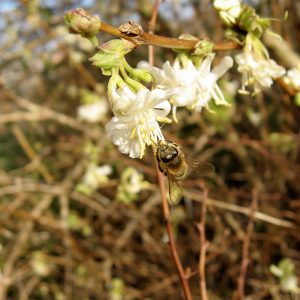
My early-flowering bumblebees are sustained by the flowers and honey bees love the winter honeysuckle (Lonicera x standishii Winter Beauty’). The evergreen Christmas box, Sarcococca confusa, provides vivid-green foliage and the flowers ooze a powerfully sweetly fragrant. There’s a headier scent from the winter-flowering Daphne bholua ‘Jacqueline Postill’. I’m getting a pleasure fix and my early flying bees are finding nectar for flight and pollen for breeding.
I deliberately plant for insect life and I will always find room for Red valerian, Centranthus ruber, because it lures in day-flying moths. It’s the favourite flower of the hummingbird hawk-moth and in June 2020 it lured in a real rarity. I spotted the narrow-bordered bee hawk-moth, a nationally scarce species that’s a priority on the BAP (Biodiversity Action Plan) list. This was only the second recorded sighting in Gloucestershire. It shows that you get more wildlife if you have a natural garden full of suitable flowers in every season.
The third thing is not to mow all your grass, because longer grass allows to you to plant native wildflowers. They’ve had centuries to develop a relationship with our native pollinators and other insects, so they’re very beneficial. You’ll also be helping brown butterflies like the ringlet, because they lay their eggs on many common grasses. These are a delight to see, lolloping round the garden in early July.
You can use self-seeding flowering bulbs and I grow Fritillaria pyrenaica with cowslips and they both flower in spring. I’m too dry to grow the Snake’s-head fritillary (Fritillaria meleagris) here because we have no water table on the high Cotswold plateau, but you may succeed in lower lying warmer places. Cowslips are far more drought-tolerant than primroses.
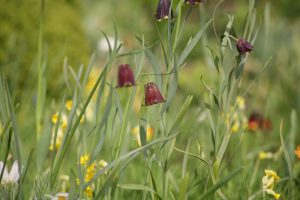
I also have unmown verges, not universally popular in the village! They accommodate wild daffodils, cowslips and meadow cranesbill. These areas of longer grass are cut once, in early September, and the clippings are removed after a day or so. These areas resisted last year’s extreme heat and drought and stayed green.
Finally, don’t be too tidy everywhere. Nature needs places to shelter and nest and that grassy, sunny bank could support lots of nesting bees. Just a few simple tweaks could help conserve what’s left and it may even bring some of it back from the brink.



